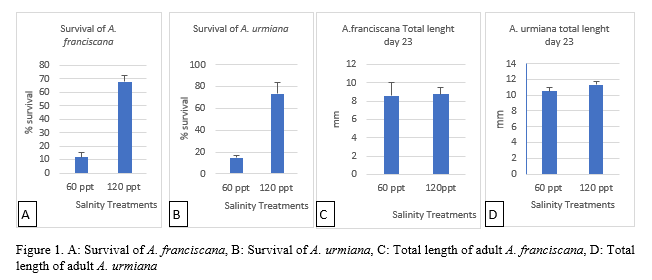USE OF DESALINATION PLANT EFFLUENT AND SALTY GROUND WATER FOR CULTURE OF ARTEMIA
Artemia, the brine shrimp, is an excellent live food for cultivable aquatic species. It is in great demand for use in shrimp and fish hatcheries. This tiny creature is a cosmopolitan taxon that has typically adapted to live in the stressful environmental conditions of higher saline habitats, such as salt lakes, lagoons and solar salt works all over the world . Many countries who do not have natural sources of Artemia have successfully set up artificial culture of Artemia using sea water. In this study we cultured Artemia franciscana and Artemia urmiana using salty effluent from a desalination plant and salty ground water respectively at 60 and 120 ppt salinities. The results showed that the survival of both A. franciscana and A. urmiana were significantly higher at 120 ppt compared to 60 ppt (Figure 1: A and B). However, the growth in both salinities did not show any significant differen ces (Figure 1: C and D). It was concluded that unconventional salty waters such as desalination plants effluent and ground salty waters may be comfortably used for artificial culture of Artemia. Both Artemia species prefer higher salinity for better performan ce. However, total lengths of adult A. franciscana and A. urmiana on day 23 were almost similar in both salinities which could be due to little number of survived animals in 60 ppt who had lesser food competition.
